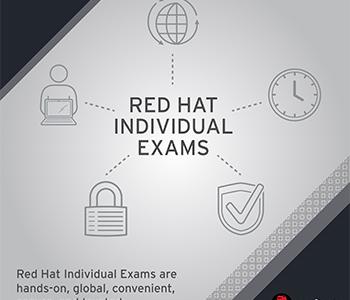Opis: Prove your skills to analyze for common issues
The performance-based Red Hat Certificate of Expertise in Red Hat Enterprise Linux Diagnostics and Troubleshooting exam (EX342) tests your ability to analyze Red Hat® Enterprise Linux® systems for common issues that may cause degradation or loss of performance and either correct the issues or gather forensic information that can be passed along to a third party.
By passing this exam you earn a Red Hat Certificate of Expertise that also counts toward earning a Red Hat Certified Architect credential.
Cel:
Grupa docelowa: The following audiences may be interested in earning the Red Hat Certificate of Expertise in Red Hat Enterprise Linux Diagnostics and Troubleshooting:
- System administrators who manage Red Hat Enterprise Linux systems
- System administrators who wish to demonstrate problem solving and analysis skills
- A Red Hat Certified Engineer (RHCE) interested in earning a Red Hat Certificate of Expertise or RHCA credential
Uwagi: Preparation
Red Hat encourages all candidates for the Red Hat Certificate of Expertise in Red Hat Enterprise Linux Diagnostics and Troubleshooting to consider taking the Red Hat Enterprise Linux Diagnostics and Troubleshooting course (RH342). Although, attendance in this class is not required to take the exam.
While attending Red Hat classes can be an important part of one’s preparation to take this exam, attending class does not guarantee success on the exam. Previous experience, practice, and native aptitude are also important determinants of success.
Many books and other resources on system administration for Red Hat’s products are available. Red Hat does not officially endorse any as preparation guides for its exams. Nevertheless, you may find additional reading deepens understanding and can prove helpful.
Exam Format
This exam is a performance-based evaluation of candidates ability to diagnose and fix or otherwise troubleshoot common problems and issues encountered when working with Red Hat Enterprise Linux. Candidates will be required to analyze and in some cases resolve issues with one or more systems and the applications running on them.
Performance-based testing means that candidates must perform tasks similar to what they perform on the job.
This exam consists of one section lasting 4 hours.
Scores and reporting
Official scores for exams come exclusively from Red Hat Certification Central. Red Hat does not authorize examiners or training partners to report results to candidates directly. Scores on the exam are usually reported within 3 U.S. business days.
Exam results are reported as total scores. Red Hat does not report performance on individual items, nor will it provide additional information upon request.
Wymagania: Red Hat recommends that candidates for the Red Hat Certificate of Expertise in Red Hat Enterprise Linux Diagnostics and Troubleshooting have:
Konspekt:
Study points for the exam
To help you prepare, the exam objectives highlight the task areas you can expect to see covered in the exam. Red Hat reserves the right to add, modify, and remove exam objectives. Such changes will be made public in advance.
Candidates for the Red Hat Certified Specialist in Linux Diagnostics and Troubleshooting exam should be able to:
- Understand and employ general methods for troubleshooting
- Collect system information to aid in troubleshooting
- Consult documentation resources to aid in troubleshooting
- Monitor systems for vital characteristics
- Configure systems to send log messages to a centralized host
- Diagnose and troubleshoot system start up issues
- Identify and resolve service failures affecting boot
- Regain root control of a system
- Troubleshoot boot issues
- Identify hardware and hardware problems
- Manage kernel modules and their parameters
- Diagnose and troubleshoot file system issues
- Recover corrupted file systems
- Recover mis-configured or broken LVM configurations
- Recover data from encrypted file systems
- Identify and fix iSCSI issues
- Resolve package management issues
- Resolve package management dependency issues
- Recover a corrupted RPM database
- Identify and restore changed files
- Troubleshoot and fix network connectivity issues
- Use standard tools to verify network connectivity
- Identify and fix network connectivity issues
- Inspect network traffic to aid troubleshooting
- Diagnose application issues
- Identify library dependencies for third-party software
- Identify if an application suffers from memory leaks
- Use standard tools to debug an application
- Identify and fix issues related to SELinux
- Identify and fix authentication issues
- Identify and fix pluggable authentication module (PAM) issues
- Identify and fix LDAP and Kerberos identity management issues
- Gather information to aid third party investigation of issues
- Create kernel crashdumps
- Compile and execute SystemTap modules
Red Hat reserves the right to add, modify, and remove objectives. Such changes will be made public in advance through revisions to this document.
As with all Red Hat performance-based exams, configurations must persist after restart without intervention.
Notyfikacja: Note: The course outline is subject to change as technology advances and the underlying job evolves. For questions or confirmation on a specific objective or topic, please contact us at osec@osec.pl
